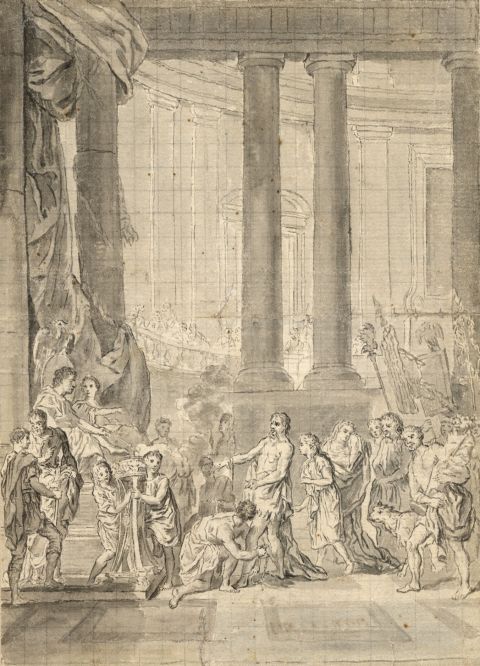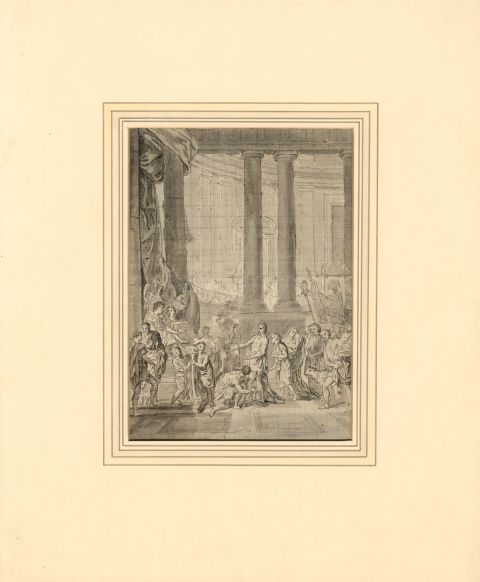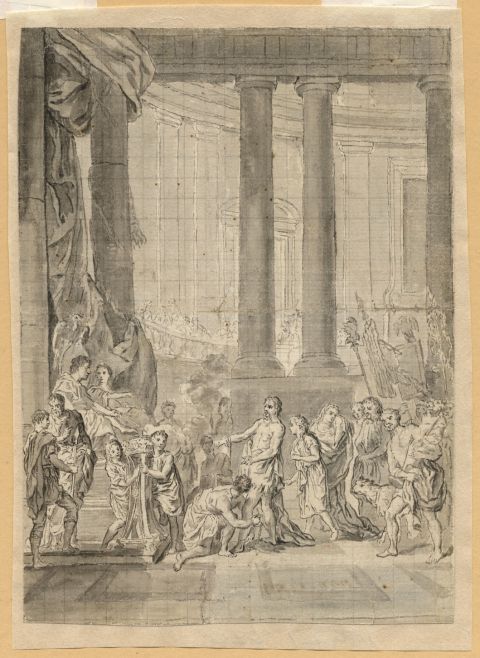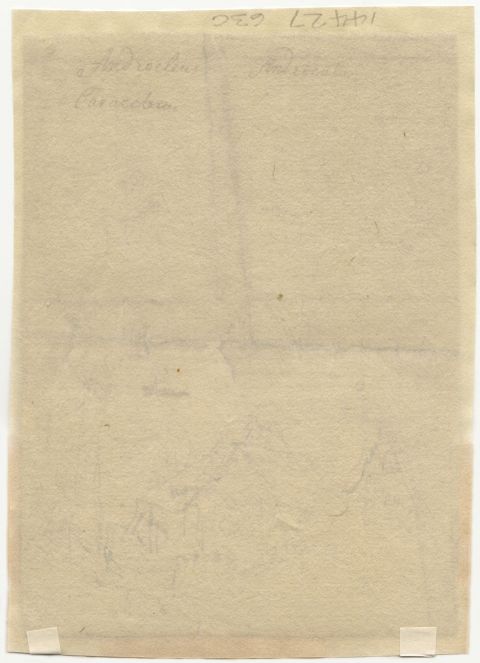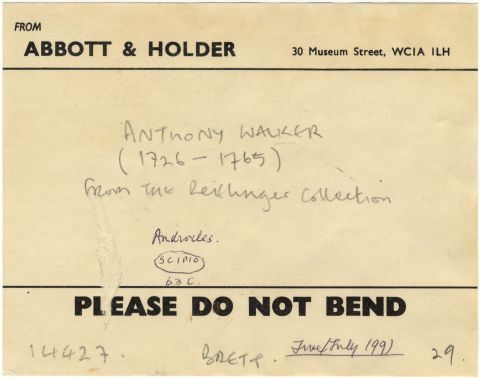This website uses cookies to ensure you get the best experience on our website. Learn more.
Anthony Walker, Emperor Hadrian Freeing Androcles – 18th-century wash drawing
An original 18th-century watercolour painting, Anthony Walker, Emperor Hadrian Freeing Androcles.
A beautifully fine grisaille ink and wash drawing by 18th-century English printmaker and draughtsman Anthony Walker (1726–1765). Walker was one of the most gifted engravers of the period, known for topographical views, religious and genre subjects, portraits and book illustrations. He was an original artist and designed original frontispieces and illustrations of great verve and style.
This animated scene shows the Roman slave Androcles being freed by the Emperor Hadrian. Androcles is a common folktale that dates back to Antiquity—a timeless story of emancipation and reciprocal mercy between man and beast. The earliest surviving account is in Aulus Gellius's 2nd century book 'Attic Nights'. Later versions of the story, sometimes attributed to Aesop, began to appear from the mid-6th century under the title 'The Shepherd and the Lion'. In 1912 George Bernard Shaw penned a play titled 'Androcles and the Lion'.
The story, in its various guises, tells of a runaway slave who encounters a wounded lion. Rather than fleeing the lion, Androcles assists in removing a large thorn from its paw. In gratitude, the lion becomes tame towards him and henceforward shares his catch with the slave. Androcles is subsequently captured and condemned to be devoured by wild animals—but the very animal that is set upon him turns out to be the same lion, which again displays its affection toward him. After questioning him, the emperor pardons Androcles in recognition of this testimony to the power of friendship, and he is left in possession of the lion.
Anthony Walker often favoured highly detailed, dramatic narrative subjects, which translate so well into print. (His illustrations for Tobias Smollett's 'The Life and Adventures of Sir Launcelot Greaves', serialised in the British Magazine (1760–1), are believed to be the earliest magazine illustrations for any serialised novel.) The present drawing is 'squared-up', indicating that it was the preparatory study for an engraved illustration. Walker's choice of Androcles as subject follows earlier print versions of different composition; in the early 16th century Agostino Veneziano depicts the slave Androcles being freed by the Emperor (see British Museum H,2.9), reputed to be after a design by Raphael. There is also an early pen and wash drawing by Baldassare Peruzzi dating from the 1530s in the Hermitage Museum.
Walker's printmaking technique was heavily reliant on etching rather than pure engraving, which meant his prints retained some of great fluidity of line seen in his draughtsmanship in ink and wash. Many of Walker's works are in the Tate collection, and this work is similar in ethos to an ink and wash drawing in the Tate titled 'Design for a Frontispiece' (T09292).
Provenance: From the Collection of Dr E.M. Brett of Hampstead. Abbott & Holder, 30 Museum Street, WC1A 1LH. Reichinger Collection.
On laid paper.
All artworks come with a Certificate of Authenticity and—if it is a collection artwork—its accompanying collection text or artist biography.
Details
Signed: No.
Inscribed: Inscribed on the verso, which shows faintly through the lining paper with which the drawing has been backed.
Condition: There are a small number of tiny scattered spots of foxing. The drawing has been professionally conserved to a high standard, the whole sheet being lined to shore up the fragility of the paper: a central horizontal fold line, with areas of repaired tear, and two short repaired tears extending from the lower edge of the sheet. As a result, these imperfections are not readily visible. Please see photos for detail.
Presented: In a cream wash line mount (33.5 x 28cm), with separate accompanying historic dealer’s label.
Born at Thirsk in North Yorkshire in 1726, Anthony Walker was the sixth son of John Walker, an exciseman. He moved to London where in 1740 he was apprenticed in the Goldsmiths' Company to the Fleet Street engraver and printseller John Tinney (d.1761). Tinney produced topographical plates and his other pupils included the celebrated engravers John Browne ARA (1742–1801) and William Woollett (1735–1785). During this period Walker also studied at the St Martin's Lane Academy. He became free of the company in 1753, after which time he was located at premises in Great Kirby Street, and then, from 1763, at the corner of Nevils Court, Fetter Lane, London. Much of Walker's early signed work was engravings after his own drawings for the book trade. Later, he became a sought-after engraver of large single-issue prints. Individual plates were exhibited at the Society of Artists from 1760 onwards, and he produced a number of fine large-scale prints after Old Master paintings for the publisher John Boydell, sometimes in collaboration with William Woollett. These were exhibited with the Incorporated Society of Artists in 1763–5. Walker also produced illustrations for instructional books, such as The Complete Drawing Book (London, 1757). His apprentices included the engravers Joseph Ryland (fl.1775–1787), Thomas Cook (1744?–1818) and Joseph Collyer (1748–1827).

